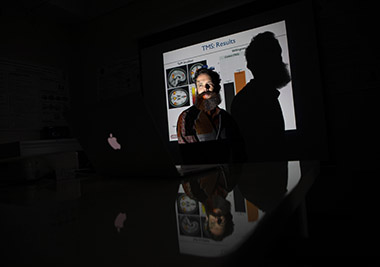From Imagination to Altruism
 |
|
Assistant professor Brendan Gaesser has been investigating the ways that our imagination impacts much more than originally thought. Photo by Patrick Dodson. |
ALBANY, N.Y. (Aug. 29, 2019) – A psychology professor has found that our imagination could be one of the keys behind our ability to help others in times of need.
Brendan Gaesser, an assistant professor who runs the Moral Cognition Lab on the Uptown Campus, is working to understand the intricacies of our imagination and morality. His lab has a particular interest in understanding how imagining the future and remembering past events can influence the moral decisions we make in the present.
Gaesser says that decisions which feel intuitive and seamless — such as providing aid to people after an accident or donating money in the aftermath of a disaster — are actually the complex result of integrating computations from multiple mental processes supported by distributed networks of brain systems.
Teaming with colleagues at Boston College, where he conducted his postdoctoral research, Gaesser investigated ways in which neural pathways in the brain support the drive to help others. The group found that when we witness others in distress, neural pathways in the brain allow us to imagine how an episode could unfold — “like generating a movie of an altruistic future action in our minds where vividly imagining these altruistic episodes motivates us to help,” Gaesser said.
“Previous research has already shown and emphasized the role of perspective-taking and emotions, such as empathy and compasson, in motivating decisions to help others. Our recent research suggests that an additional factor influencing these decisions is how easily our brains can construct both imagined and previous episodes in which we’ve helped.”
Published in Oxford Academic’s Social Cognitive and Affective Neuroscience, the study consisted of two experiments looking at areas of the brain with different functions: The medial temporal lobe (MTL), which supports memory and the simulation of imagined visuospatial scenes, and the right temporoparietal junction (RTPJ), which processes information and helps us take the perspective of others by experiencing what they would think and feel.
In the first experiment, they scanned participants with functional neuroimaging technology as they were asked to imagine and remember situations where they helped others. In the second part of the study, the team used transcranial magnetic stimulation, a form of non-invasive brain stimulation, to disrupt activity in the RTPJ.
“By disrupting activity in the RTPJ we could better isolate the contribution of the MTL to people’s willingness to help others,” said Gaesser.
The results revealed that the willingness to help others was predicted by activity in both the MTL and RTPJ but found that the effect of willingness to help others remained the same even when activity in the RTPJ was disrupted – suggesting that activity in the MTL may be what primarily drives and effect of imagination on our decisions to help.
“Though more research is ongoing in this area, it appears that our willingness to help other in need may be guided, in part, by how easily we can construct imagined and remembered helping episodes in our minds and brains,” said Gaesser.
To read the full study, visit the journal.
![]() For more news, subscribe to UAlbany's RSS headline feeds
For more news, subscribe to UAlbany's RSS headline feeds
A comprehensive public research university, the University at Albany-SUNY offers more than 120 undergraduate majors and minors and 125 master's, doctoral and graduate certificate programs. UAlbany is a leader among all New York State colleges and universities in such diverse fields as atmospheric and environmental sciences, business, education, public health,health sciences, criminal justice, emergency preparedness, engineering and applied sciences, informatics, public administration, social welfare and sociology, taught by an extensive roster of faculty experts. It also offers expanded academic and research opportunities for students through an affiliation with Albany Law School. With a curriculum enhanced by 600 study-abroad opportunities, UAlbany launches great careers.


